Paella
Paella (/paɪˈɛlə/ py-EL-ə,[1] Valencian: [paˈeʎa], Spanish: [paˈeʎa]) is a Spanish rice dish originally from Valencia.
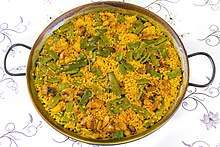 Paella valenciana | |
| Course | Main course |
|---|---|
| Place of origin | Spain |
| Region or state | Valencia |
| Serving temperature | warm |
| Main ingredients | Short grain rice, chicken, rabbit, vegetables, saffron |
Paella is one of the best-known dishes in the Spanish cuisine. For this reason, it may be seen internationally as Spain's national dish, but Spaniards almost unanimously consider it to be a dish from the Valencian region; those who live there, in turn, regard paella as one of their identifying symbols.[2][3]
Paella takes its name from the wide, shallow traditional pan used to cook the dish on an open fire. Paella means "frying pan" in Valencian, Valencia's regional language.
As a dish, it may have ancient roots, but in its modern form it is traced back to the mid-19th century, in the rural area around the Albufera lagoon adjacent to the city of Valencia, on the east coast of Spain.[4]
Paella valenciana is the traditional paella of the Valencia region, believed to be the original recipe,[5] and consists of round grain rice[6], bajoqueta and tavella (varieties of green beans), rabbit, chicken, sometimes duck, garrofó (a variety of lima or butter bean),[7][8] and optionally snails. Artichoke hearts and stems may be used as seasonal ingredients. Olive oil is used as a base, and saffron and (sometimes) whole rosemary branches are used as seasoning.
Paella de marisco (seafood paella) replaces meat with seafood and omits beans and green vegetables, while paella mixta (mixed paella) combines meat from livestock, seafood, vegetables, and sometimes beans, with the traditional rice.
Other popular local variations of paella are cooked all through the Mediterranean area, the rest of Spain and internationally.
History
Possible origins

Moors in Muslim Spain began rice cultivation around the 10th century.[9] Consequently, eastern Iberian Península locals often made casseroles of rice, fish, and spices for family gatherings and religious feasts, thus establishing the custom of eating rice in Spain. This led to rice becoming a staple by the 15th century. Afterwards, it became customary for cooks to combine rice with vegetables, beans, and dry cod, providing an acceptable meal for Lent. Along Spain's eastern coast, rice was predominantly eaten with fish.[10][11]
Spanish food historian Lourdes March notes that the dish "symbolizes the union and heritage of two important cultures, the Roman, which gives us the utensil and the Arab which brought us the basic food of humanity for centuries."[12]
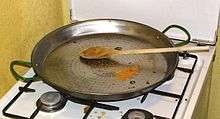
Naming, etymology and paellera
Paella is a Valencian word that means frying pan.[13][14][15] The dish gets its name from it.[14][15] Valencian speakers use the word paella for all pans, including the traditional shallow pan used for cooking the homonym dish.[15] The pan is made out of polished or coated steel with two side handles.[16]
In many regions of Spain and other Spanish-speaking countries, the term paellera may be used for the traditional pan, while paella is reserved for the rice dish prepared in it. Both paella and paellera are correct terms for the pan.[17]
The word paella may derive from the Old French word paelle[13][18] for frying pan, which in turn comes from the Latin word patella for pan.
The word paella is also related to paila used in many Latin American countries. Paila in Latin American Spanish refers to a variety of cookware resembling metal and clay pans, which are also used for both cooking and serving.
The Latin root patella from which paella derives is also akin to the modern French poêle,[19] the Italian padella,[20] and the Old Spanish padilla.[21]
Some claim that the word paella comes from the Arabic بَقَايَا, pronounced baqaayya, meaning "leftovers".[22] This claim is based on the 8th-century custom in which Moorish kings' servants would take home the rice, chicken, and vegetables their employers left at the end of the meal.[23][24][25][26] It has been said, however, that a problem with this etymology is that the word paella is not attested until six centuries after Moorish Valencia was conquered by Jaume I.[27]
Paella Valenciana
Originally, paella made in Valencia was a lunchtime meal for farmers and farm laborers. Workers would gather what was available to them around the rice fields. This often included tomatoes, onions, and snails. Rabbit or duck was a common addition, or chicken less often.[28]
On special occasions, 18th century Valencians used calderos to cook rice in the open air of their orchards near lake Albufera. Water vole meat was one of the main ingredients of early paellas,[29] along with eel and butter beans. Novelist Vicente Blasco Ibáñez described the Valencia custom of eating water voles in Cañas y Barro (1902), a realistic novel about life among the fishermen and peasants near lake Albufera.[30]
Living standards rose with the sociological changes of the late 19th century in Spain, giving rise to gatherings and outings in the countryside. This led to a change in paella's ingredients, as well, using instead rabbit, chicken, duck and sometimes snails. This dish became so popular that in 1840, a local Spanish newspaper first used the word paella to refer to the recipe rather than the pan.[10]
The most widely used, complete ingredient list of this era was: short-grain white rice, chicken, rabbit, snails (optional), duck (optional), butter beans, great northern beans, runner beans, artichoke (a substitute for runner beans in the winter), tomatoes, fresh rosemary, sweet paprika, saffron, garlic (optional), salt, olive oil, and water.[10] Poorer Valencians, however, sometimes used nothing more than snails for meat. Valencians insist that only these ingredients should go into making modern paella valenciana.
Seafood and mixed paella
On the Mediterranean coast, Valencians used seafood instead of meat and beans to make paella. Valencians regard this recipe as authentic, as well. In this recipe, the seafood is served in the shell. A variant of this is paella del senyoret which uses seafood without shells. Later, however, Spaniards living outside of Valencia combined seafood with meat from land animals and mixed paella was born.[31] This paella is sometimes called preparación barroca (baroque preparation) due to the variety of ingredients and its final presentation.[32]
During the 20th century, paella's popularity spread past Spain's borders. As other cultures set out to make paella, the dish invariably acquired regional influences. Consequently, paella recipes went from being relatively simple to including a wide variety of seafood, meat, sausage (including chorizo),[33][34] vegetables and many different seasonings.[35] However, the most globally popular recipe is seafood paella.
Throughout non-Valencia Spain, mixed paella is relatively easy to find. Some restaurants both in Spain and abroad that serve this mixed version refer to it as Paella valenciana. However, Valencians insist that only the original two Valencia recipes are authentic, and generally view all others as inferior, not genuine or even grotesque.[31]
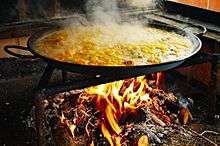
Basic cooking methods
According to tradition in Valencia, paella is cooked over an open fire, fueled by orange and pine branches along with pine cones.[36] This produces an aromatic smoke which infuses the paella.[37] Also, dining guests traditionally eat directly out of the pan instead of serving in plates.[4][10][31][38]
Some recipes call for paella to be covered and left to settle for five to ten minutes after cooking.
After cooking paella, there may be a layer of roasted rice at the bottom of the pan, called socarrat in Valencià. The layer develops on its own if the paella is cooked over a burner or open fire. This is traditionally considered positive (for as long as it is not scorched) and Valencia natives enjoy eating it.[39]
Paella valenciana
| Wikibooks Cookbook has a recipe/module on |

This recipe is standardized[38][40][41][42] because Valencia originals consider it traditional and very much part of their culture. Rice in paella valenciana is never braised in oil, as pilaf, though the paella made further southwest of Valencia often is.
- Heat oil in a paella.
- Sauté meat after seasoning with salt.
- Add green vegetables and sauté until soft.
- Add garlic (optional), grated tomatoes, beans and sauté.
- Add paprika and sauté.
- Add water, saffron (or food coloring), snails (optional) and rosemary.
- Boil to make broth and allow it to reduce by half.
- Remove the rosemary once flavour has infused or it starts to fall apart.
- Add rice and simmer until rice is cooked.
Some people enjoy garnishing their served plate with freshly squeezed lemon.
Paella de marisco (Seafood paella)
| Wikibooks Cookbook has a recipe/module on |
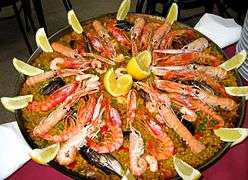
Recipes for this dish vary somewhat, even in Valencia. The recipe below is based on the two cited here.[43][44]
- Make a seafood broth from shrimp heads, onions, garlic and bay leaves.
- Heat oil in a paella.
- Add mussels. Cook until they open and then remove.
- Sauté Norway lobster and whole, deep-water rose shrimp. Then remove both the lobster and shrimp.
- Add chopped cuttlefish and sauté.
- Add shrimp tails and sauté.
- Add garlic and sauté.
- Add grated tomato and sauté.
- Add rice and braise in sofrito.
- Add paprika and sauté.
- Add seafood broth and then saffron (or food coloring).
- Add salt to taste.
- Add the deep-water rose shrimp, mussels and Norway lobster that were set aside.
- Simmer until rice is cooked.
Paella mixta (Mixed paella)
| Wikibooks Cookbook has a recipe/module on |
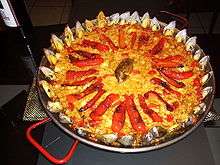
There are countless mixed paella recipes. The following method is common to most of these. Seasoning depends greatly on individual preferences and regional influences. However, salt, saffron, and garlic are almost always included.[45][46][47]
- Make a broth from seafood, chicken, onions, garlic, bell peppers, and bay leaf.
- Heat oil in a paella.
- Sear red bell pepper strips and set aside.
- Sear crustaceans and set aside.
- Season meat lightly with salt and sauté meat until golden brown.
- Add onions, garlic and bell peppers. Sauté until vegetables are tender.
- Add grated tomatoes and sauté.
- Add dry seasonings except for salt.
- Add rice.
- Braise rice until covered with sofrito.
- Add broth.
- Add salt to taste.
- Add saffron (or food coloring) and mix well.
- Simmer until rice is almost cooked.
- Replace crustaceans.
- Continue simmering until rice and crustaceans are finished cooking.
- Garnish with seared red bell pepper strips.
Variants
Philippines
Arroz a la valenciana (Spanish) or Arroz à valenciana (Portuguese) is considered as a part of Philippine cuisine. It is considered as the Philippine version of paella.[48]
The Philippine version uses glutinous rice, otherwise the ingredients are the same. In the Philippines, arroz a la valenciana refers to chicken, and longganisa (chorizo) versions.[49]
In popular culture
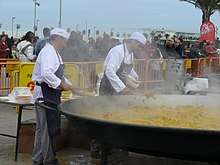
Competitions and records
It has become a custom at mass gatherings in the Valencia region (festivals, political campaigns, protests, etc.) to prepare enormous paellas, sometimes to win a place in the Guinness World Records book. Chefs use gargantuan paelleras for these events.
Valencia restaurateur Juan Galbis claims to have made the world's largest paella with help from a team of workers on 2 October 2001. This paella fed about 110,000 people according to Galbis' former website.[50] Galbis says this paella was even larger than his earlier world-record paella made on 8 March 1992 which fed about 100,000 people. Galbis' record-breaking 1992 paella is listed in Guinness World Records.[51]
Controversial representations
Some non-Spanish chefs include chorizo in their paellas along with other ingredients which Valencia people believe do not belong in paella of any type. The alternative name proposed for these dishes, although pejorative, is arroz con cosas ('rice with things'). Famous cases are Jamie Oliver's paella recipe (which included chorizo)[52][53] and Gordon Ramsay's.[54] The author Josep Pla once noted:
The abuses committed in the name of Paella Valenciana, are excessive – an absolute scandal.
— Josep Pla, Catalan Cuisine, Revised Edition: Vivid Flavors From Spain's Mediterranean Coast
However, in an article for El País, Spanish food writer Ana Vega 'Biscayenne', citing historical references, showed that traditional Valencian paella did indeed include chorizo, exclaiming, "Ah Jamie, we'll have to invite you to the Falles".[55]
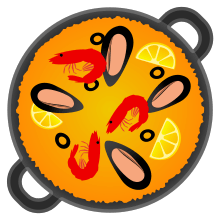
Related dishes
| Wikibooks Cookbook has a recipe/module on |

Traditional Valencia cuisine offers recipes similar to paella valenciana and paella de marisco such as arròs negre, arròs al forn, arròs a banda and arròs amb fesols i naps, since rice is the base of lots of local cuisine.
Fideuà is a pasta noodle dish variation cooked in a similar fashion in a paella. It may be served with allioli sauce.
Paella descendants
- Arroz a la valenciana – Latin American and Filipino adaptation of meat paella, uses annatto instead of saffron
- Arroz con gandules – Puerto Rican adaptation, also uses annatto
- Arroz con pollo – Latin American adaptation with chicken, also uses annatto
- Bringhe – pre-colonial Filipino dish derived from biryani dishes but merged with paella during the colonial period. Uses glutinous rice, turmeric, and uniquely, coconut milk.
- Jambalaya – Louisiana dish influenced by paella and the French jambalaia from Provence
- Locrio – Dominican descendant of paella.[58]
- Paelya – Filipino adaptation of paella that distinctively use glutinous rice, also uses annatto, turmeric, or safflower. Also spelled "paella", but pronounced differently.[59]
Other dishes
- Arròs negre – sometimes called "paella negra", a similar Catalonia and Valencia dish using squid ink
- Biryani – a similar dish from the Indian subcontinent
- Bisi Bele Bath – a similar dish from India
- Jollof rice – a similar dish from West Africa
- Kabsa – a similar dish from the Middle East
- Pilaf – a similar dish from Central Asia
- Risotto – similar northern Italian dish
- Thieboudienne – a similar dish from Mauritania and Senegal
See also
References
- "paella". Oxford Dictionaries UK Dictionary. Oxford University Press. Retrieved 22 January 2016.
- "Paella, on the way to becoming a World Heritage Site". Generalitat Valenciana. Retrieved 19 February 2020.
For the Region of Valencia, paella is much more than a recipe, it is a ritual and an icon of our culture.
- Panadero, Amparo (11 March 2019). "La paella valenciana quiere ser Patrimonio de la Humanidad". Diario16 (in Spanish). Retrieved 19 February 2020.
En el caso de la paella valenciana, se trata de una tradición culinaria y social que constituye un icono de hospitalidad y un símbolo de unión e identidad valencianas ...
- "Info about Paella on About.com". Spanishfood.about.com. 15 December 2009. Retrieved 19 February 2010.
- Saveur, "The Art of Paella" (accessed 21 July 2015)
- Paella Rice (accessed 12 April 2020)
- Phaseolus lunatus L. var. macrocarpus Benth.
- "La Bible de la Paella: The Garrofon". Retrieved 5 September 2018.
- Watson, Andrew (1983). Agricultural innovation in the early Islamic world. Cambridge University Press. ISBN 0-521-06883-5.
- Lynne Olver (16 September 2009). "The Food Timeline presents a history of paella". Foodtimeline.org. Retrieved 19 February 2010.
- Tom Jaine (1989). The Cooking Pot: Proceedings. Oxford Symposium. p. 104. ISBN 978-0-907325-42-0.
- March, Lourdes (1999), "Paella", in Davidson, Alan (ed.), The Oxford Companion to Food, Oxford: Oxford University Press, pp. 566–567, ISBN 0-19-211579-0
- "Merriam Webster's definition and etymology of the word paella". Retrieved 8 June 2012.
- "Diccionari normatiu valencià". www.avl.gva.es. Retrieved 2 November 2019.
- "Diccionario de la Real Academia Española's (DRAE) definition and etymology of Paella". Retrieved 11 October 2012.
- "El recipiente". Lapaella.net. Retrieved 19 February 2010.
- The Royal Spanish Academy's definition of ''paellera''. Buscon.rae.es. Retrieved on 5 October 2016.
- "Paella | Definition of Paella by Lexico". Lexico Dictionaries | English. Retrieved 2 November 2019.
- Origin of ''poêle''. Littre.org. Retrieved on 5 October 2016.
- "Etimologia : padella;". etimo.it.
- "Meaning of the Spanish word ''padilla''". Spanishdict.com. Retrieved 19 February 2010.
- حكاية طبق - باإييلا / إسبانيا, retrieved 30 October 2019
- Ruiz, Ana (2007). Vibrant Andalusia: The Spice of Life in Southern Spain. Algora Publishing. ISBN 9780875865409.
- Webster, Jason (3 August 2010). Andalus: Unlocking The Secrets Of Moorish Spain. Transworld. ISBN 9781407094816.
- Guthrie, Shirley (1 August 2013). Arab Women in the Middle Ages: Private Lives and Public Roles. Saqi. ISBN 9780863567643.
- Richardson, Paul (21 August 2007). Late Dinner: Discovering the Food of Spain. Simon and Schuster. ISBN 9781416545392.
- Duhart, Frédéric; Medina, F. Xavier. Els espais socials de la paella: antropologia d’un plat camaleònic. Revista d'etnologia de Catalunya. p. 89.
- "History and Origins of Paella". The Paella Company. Retrieved 16 March 2020.
- Manuel Vázquez Montalbán, La cocina de los mediterráneos, Ediciones B – Mexico
- "César Besó Portalés, ''Vicente Blasco Ibáñez y el Naturalismo'', I.E.S. Clara Campoamor, Alaquás (Valencia)". Ucm.es. Retrieved 19 February 2010.
- Tu nombre. "Arroz SOS presents a history of paella". Arrozsos.com. Archived from the original on 25 January 2010. Retrieved 19 February 2010.
- "Nuestras Paellas". Pacharán. Archived from the original on 16 November 2015. Retrieved 2 September 2015.
- Mario Batali's version of mixed paella with chorizo Oprah.com: Retrieved 30 June 2011
- Recipe courtesy Tyler Florence. "Foodnetwork's paella recipe with seafood, chicken and chorizo". Foodnetwork.com. Retrieved 19 February 2010.
- "An assortment of paella recipes". Spain-recipes.com. Retrieved 19 February 2010.
- "Arros QD's Quique Dacosta on why paella will be the dish of the summer". Evening Standard. 5 June 2019. Retrieved 18 December 2019.
- Curtis, Nick (2 June 2019). "Michelin-starred chef Quique Dacosta on how to make the ultimate paella". The Telegraph. ISSN 0307-1235. Retrieved 18 December 2019.
- "Authentic Paella Valenciana as it is made in Valencia". paellarecipes.top. Retrieved 23 December 2019.
- Dacosta, Quique (6 August 2019). "My kitchen essential: I'd be lost without . . . my paella pan". www.ft.com. Retrieved 14 February 2020.
- "Restaurante Galbis – Restaurante,restaurantes L'alcudia – Valencia". waybackmachine.org. Archived from the original on 20 April 2009.CS1 maint: unfit url (link)
- Marquès, Vicent (2004): Els millors arrossos valencians. Aldaia: Edicions Alfani.
- "Author Jason Webster's method for making Valencian paella". jasonwebstersblog.com. Archived from the original on 13 July 2011. Retrieved 28 December 2010.
- "Chef Juanry Segui's recipe for seafood paella". YouTube. Retrieved 27 February 2017.
- "Recipe for seafood paella". YouTube. Retrieved 27 February 2017.
- "Mixed paella recipe". Spain-recipes.com. Retrieved 19 February 2010.
- "A Spanish grandmother near Madrid cooks her mixed paella recipe on video". Youtube.com. Retrieved 19 February 2010.
- Mixed paella recipe on the ''Hay Recetas'' website. Hayrecetas.com. Retrieved on 5 October 2016.
- https://www.saveur.com/philippine-seafood-paella-recipe/
- "Arroz Valenciana Recipe". Pinoy Recipe At Iba Pa. Retrieved 13 August 2011.
- "Paellas gigantes – Catering y paellas para eventos – Comidas gigantes". Paellas Gigantes.
- "Galbis's 1992 record listed on the Guinness website". Guinnessworldrecords.com. Retrieved 19 February 2010.
- Oliver, Jamie. (16 September 2015) Chicken & chorizo paella | Rice Recipes. Jamie Oliver. Retrieved on 2016-10-05.
- "Jamie Oliver's paella recipe is panned online". BBC News. BBC. 30 October 2014. Retrieved 5 January 2016.
- Vega, Ana (2 March 2016). "Chefs que destrozan la comida española". El País (in Spanish) (El Comidista). Retrieved 5 October 2016.
- Vega, Ana (14 October 2016). "La paella sí llevaba chorizo". El País (in Spanish) (El Comidista). Retrieved 13 June 2018.
- Gonzalez Capella, Antonio (1 February 2015). "ISO/IEC JTC 1/SC 2/WG 2 PROPOSAL SUMMARY FORM TO ACCOMPANY SUBMISSIONS FOR ADDITIONS TO THE REPERTOIRE OF ISO/IEC 10646 1" (PDF). Unicode. Retrieved 10 March 2017.
- "Paella Emoji". Emojipedia. Retrieved 10 March 2017.
- Aunt Clara's Kitchen. "Locrio de Pollo". Retrieved 18 March 2014.
- "Arroz Valenciana". Panlasang Pinoy Meaty Recipes. Retrieved 14 December 2018.
Further reading
- March, Lourdes (1985). El Libro De La Paella Y De Los Arroces. Madrid: Alianza. ISBN 8420601012.
- Ríos, Alicia and Lourdes March (1992). The Heritage of Spanish Cooking. New York: Random House. ISBN 0-679-41628-5.
| Wikimedia Commons has media related to Paella. |
.svg.png)